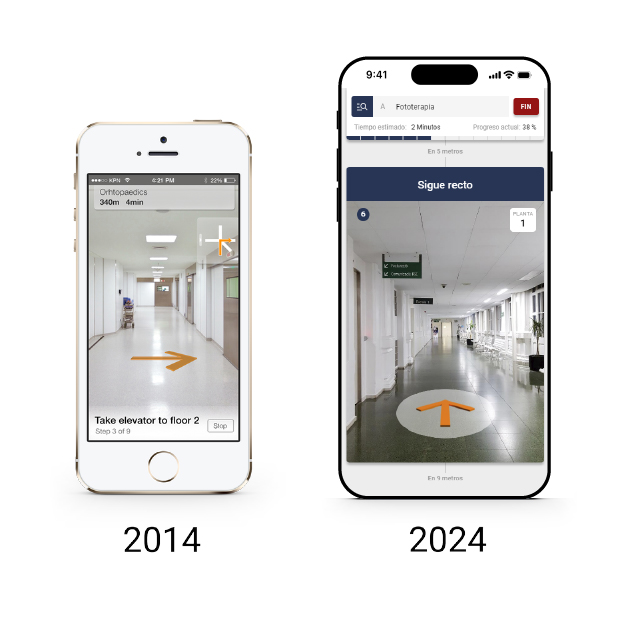People don’t like to download digital wayfinding applications in hospital interiors.
“Failure is simply the opportunity to begin again, this time more intelligently.” – Henry Ford
How our biggest mistake became our greatest strength
This September marks 10 years since we developed the first prototype of Eyedog. Back then, our wayfinding system was just a very complicated excel (what were we thinking?), not to mention the problems we had with the different screens of the iPhone 4 and iPhone 5. It was a real nightmare.
Long before everyone started creating apps, we were already imagining a future where cell phones would guide us inside buildings, replacing the traditional signs that were so limited. We’d had this idea since 1996, reinforced by conversations with ‘Mr. Wayfinding’, who had designed the first mobile phone app in 1996. Mr. Wayfinding’, who had designed wayfinding systems for almost 50 hospitals over 35 years. After two decades of reflection and interface discussions, we had a revelation: a wayfinding app. A native app for iOS and Android seemed like the perfect solution, or so we thought….
But boy, were we wrong. 🤦🏻♂️
It turns out that people didn’t want to download apps just to find their destination. It didn’t matter how good the app was; people just weren’t interested.

Why Patients Don’t Download Wayfinding Apps
Patients want clear and useful information about their appointments and how to get around the hospital. However, if they have to download an app, search for it in the App Store or Google Play Store and learn how to use it without it being immediately useful at home, they quickly lose interest.
At home, they don’t have an urgent problem finding a destination, so using the app seems like an unnecessary effort.
It’s like offering an umbrella on a sunny day just because it might rain tomorrow.
Once in the hospital, no one downloads an app.
In fact, people have already forgotten that they might download an app that solves an orientation problem, which they are not having at the time.
Most will not even notice that this app is mentioned in the appointment they received at home and will just walk into the hospital.
People are only aware that they have a wayfinding problem when they get lost, and at that point, they don’t think: “Does the hospital have a wayfinding app? I’m going to look it up in the app store, download it, learn how to use it, and then find where I need to go.”
By that time, they’ve already asked someone who works at the hospital, which is precisely what we’re trying to avoid.
Want to check it out? Just search for some hospital wayfinding apps and look at the number of downloads in App Store or Google Play Store, you will see that the downloads are surprisingly low.
The necessary change
Our competitors realized the same problem, and the skeptics repeated that “if no one uses it, then no one sees the concept as valuable.”
But this is where the magic of innovation comes in : it arises in the face of challenges. Some competitors became digital service providers, adding more value by integrating services such as urgent care, appointment scheduling and access to medical records, as well as wayfinding into their applications. Most wayfinding solution providers disappeared or switched to being technology providers.
Our path was different. From an app-based strategy, we moved to an API-centric strategy (an integrated app). The key? Wayfinding had to integrate seamlessly into the routine of patients and visitors. In healthcare, the ability of systems to connect and communicate became very important, helping to share information and coordinate data from different sources.
Our biggest mistake has become our greatest asset today. From the ashes of our app-centric approach, we have created a digital guidance solution that is very easy to implement. It can be integrated into strategic communication points in a very simple way, providing personalized counseling information to patients.
This innovation now offers patients a natural and simple way to find their destination with ease.
Our race towards adaptation, learning and evolution has led us to a solution that not only solves our past mistakes, but also strengthens our commitment to redefine wayfinding meaningfully and intuitively. 🌟